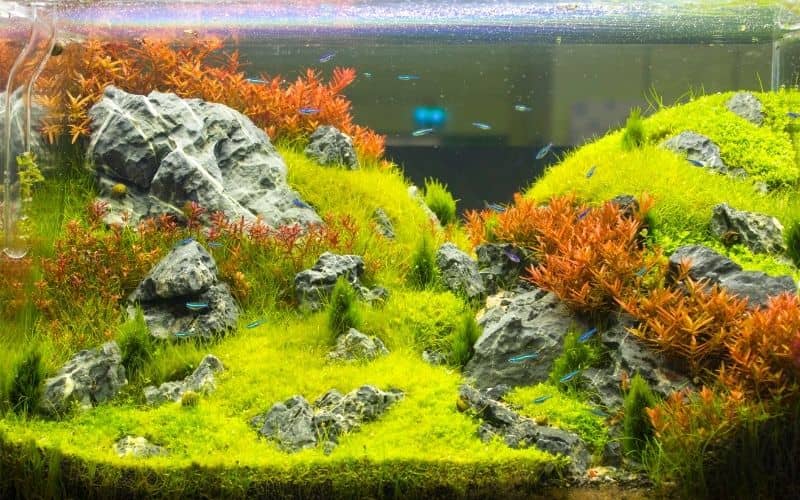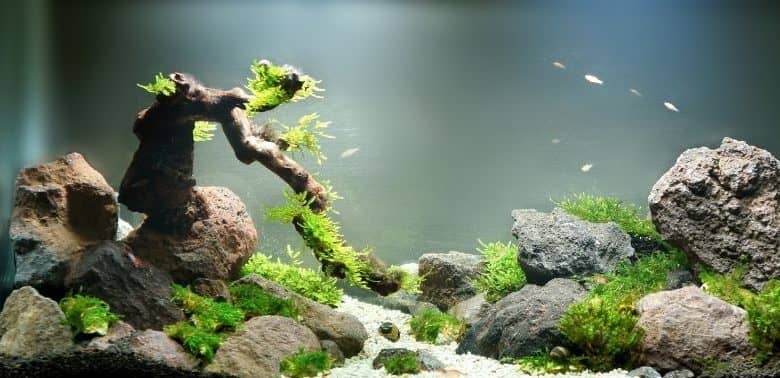How long do aquascapes last? Generally, the Aquascape can last approx six months. However, you have to follow strict maintenance guidelines to keep your plants alive. The underwater plants require a sufficient amount of light to produce food for their growth. Also, the oxygen level in the water determines how plants will grow.
When their natural cycle is managed, the plant will show fast growth.

How do you maintain Aquascape?
The maintenance of the Aquascape is crucial for the development of plants. When you keep your plants in their natural habitat, it produces more aquatic plants and grow extensively, covering the tank’s large space. In a few months, the Aquascape will cover the entire fish tank giving it an extraordinary look. you do not need to be a professional aquascaper or aquarist.
Once the plant has adjusted to the new environment, it will spread in the other direction and may break the water surface to find its way. Even the plants moving outside of the water look fantastic in the tank. You can cover the entire tank with the Aquascape and surrounding to make the space look amazing.
Here are some of the guidelines you may have to follow to maintain your Aquascape for long-term growth and sustainability.
1) Clean Aquarium Glass:
if there is less water movement in the fish tank, which helps produce algae that cover the inside of the aquarium glass. Over the period, the glass will be covered with green algae causing the tank to look dirty. It would help if you regularly clean the tank from the inside, especially the aquarium glass.
2) Trim aquatic plants:
If you find the brand of any of the aquarium plants is growing exponentially and damaging the appearance, it is good to trim them early to avoid them spreading around the water. It may block the view and fill the aquarium with plant leaves everywhere. You have to ensure that the fish kept in the tank would get sufficient space to swim.
Ultimately, the hard work you are putting in Aquascape is for the fish you put water in the tank. If your Aquascaping cannot provide the natural habitat that your fish would enjoy, the efforts you put into the Aquascape would be futile.
3) Remove organic waste:
The plant would produce organic waste during its growth period. Such as leaves, broken branches, etc. Remove the waste product from the aquarium before it starts decomposing. unlike nature aquariums, they can accumulate and cause problems.
4) Filter Cleaning:
Clean your filter regularly to clean the water. Algae make the filter their home. As the waste product gets sucked into the filter, the algae would multiply quickly and make your filter filled with algae’s small size.
As the algae spread in the filter, they also produce a waste product, making the water dirty and stink. Cleaning filters regularly would keep your water clean and waste products out of the tank.
5) Clean decorative:
The Aquascape typically takes one or one and a half months to develop completely. During this period, decoratives used in the tank would become the home for the algae, viruses, and bacteria. For example, the rock used in the Aquascape would naturally attract the bacteria to inhabitants, and over time they would produce the waste product, which then floats in the water.
Cleaning the decorations frequently would keep your water clean and oxygen-rich.
6) Weekly water change:
Water change is the normal procedure every aquarium owner should perform to keep the water clean and breathable for living species.
The water gets filtered with fresh groundwater, or the river water’s moving river bodies or the lake. Clean water contains the nutritional substance also it is filled with high oxygen levels. The water in the tank, which is stagnant, would reduce the oxygen over time as the aquatic plants and fish start consuming it.
It is recommended to perform a 50% water change every week to keep your Aquascape in better. so water changes are a must.
7) Check the Health of Livestock:
Keep an eye on the livestock to ensure that they are having a great time in the aquarium. Some plants found in the water are dangerous to some of the species of fish. When fish gets in contact with the plants or eat them, they fall sick. If you find the fish is behaving differently than normal, then there are chances that the fish has trouble breathing or chemical produced by the plant make them feel ill.
Immediately remove the fish from the aquarium and keep them in a separate tank until they recover from the illness.
8) Check temperature:
Temperature management is essential for the fish as well as the aquatic plants. The rising temperature would reduce the oxygen level in the water, causing damage to the livestock.
Use the temperature management equipment for the aquarium that keeps track of the water temperature. If you have a heater for controlling the temperature in the aquarium, then confirm that it is working as usual.
The cold temperature would create an unbreathable environment for the fish, and your fish would die. also using good quality LED light can reduce tank temperature.
9) CO2 Level:
Ensure the CO2 Level in the water is under control. Increasing CO2 Levels would make the fish ill. Aquascaping also shows slow growth when the CO2 level is rising in the water.
10) Nutrient deficiencies:
The plant also develops nutrient deficiencies when it does not get a sufficient amount of food. You will see the growth of the aquatic plants reduces.
The expansion slows down, and some of the plants will get rotten early. It would help if you controlled the water’s nutritional factors by changing the water frequently with fresh water. In the early days when your Aquascape is growing, you should change the water regularly, so the plant would have sufficient time to grow. some times CO2 injection needs to be done.

Are Planted aquariums hard to maintain?
The planted aquariums or planted tanks are easy to maintain. It doesn’t require much effort to arrange the aquatic plants. Once you put the plants in place, they will grow naturally. (For example bamboo) However, it would help if you planned your plantation before laying the plant in the aquarium. Do not block the entire tank with the plant. Leave sufficient space for the fish to move.
If you find any of the aquarium plants consuming more space when they grow, trim them to clear the space for the fish. Special attention should be taken to the tank dimension, lighting, substrate, fertilizers, and type of fish in the aquarium.
The plant grows quickly when the habitat is natural and the plant receives a sufficient amount of fresh water. Also, the naturally produce nutrition from the fish waste also contributes to plant growth. You can maintain the underwater garden efficiently without touching the plant or managing the plant’s growth personally.
Control water temperature, freshwater, nutrients, sunlight if possible, and fish. When you control all these matters effectively, your aqua-scaping would be successful. Within a month or two, you will have a fully developed aquascape in the home.
Read more Aquascaping Advanced Guide-Learn Professional Aquascaping
Read more How To Create A Forest Aquascape? 3 Simple Steps
Conclusion: How long do aquascapes last
Aquascaping looks good in the tank, especially when it is developed in the household aquarium. However, it requires more planning and regular checking until your Aquascape becomes mature. Once it is fully developed, it grows naturally without needing much effort.
The first month would be challenging, and you may have to control several aspects of the aquarium at the same time to control the natural habitat.
You can extend the aquascapes growth for a year if you manage it like a professional aquarist. Remember that it is a time-consuming job. You may have to dedicate your time to managing the aquarium and livestock.
Read more Is It Safe To Put Dried Bamboo In An Aquarium?
Read more Can I Use Outdoor Gravel Or Rocks In an Aquarium? How To Use Them
